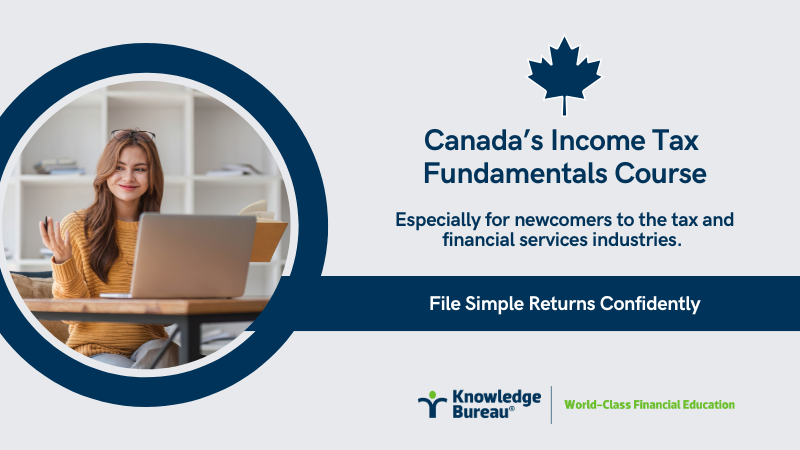Get Hooked on Preparing Taxes!

New! Get hooked on preparing income taxes for tax season 2025 with dozens of true-to-life case studies using professional tax software to build your confidence. It’s Knowledge Bureau’s Canada’s Income Tax Fundamentals, now available for online training. It features a dynamic 3 hour instructional overview - worth the price of admission on it’s own plus personal instructor support! It’s perfect for anyone new to personal tax filing - really valuable for career development in tax preparation or financial services. Here are the details.
“Perfect for anyone moving from NETFILE to EFILE in preparing returns for friends and family and especially valuable for career development in the tax preparation or financial services.”
The 20 hour online course curriulum:
- Understanding Canada’s Digital Tax System

- What Income is Taxable
- Claiming Refundable Tax Credits and Social Benefits
- Claiming Non-Refundable Tax Credits
- Claiming Deductions
- Reporting Income from Self-Employment
- Reporting Capital Gains
- Rental Income
- Practice Management Thesis – Using Your Tax Software
Prepare simple tax returns for households including individual employees, families and seniors with confidence – you’ll receive lots of practice to perfect your skills and a professional library of resources, too, to help you become an “investigative tax reporter”!
What is Included (see Chapter details below)
- Personal course selection consultation
- Virtual campus orientation
- All your Lesson and study plans
- Personal instructor email support
- Comprehensive Knowledge Journal featuring 8 chapters
- EverGreen Online Research Library featuring over 800 tax topics
- Student versions of Professional Tax Software – Taxcycle, DTMax or Profile
- Testing and certification
- CE/CPD accreditation
- Tax receipting
Register now – only $395 plus taxes. Online: https://learn.knowledgebureau.com/courses/canadas-income-tax-starter-program
Or Call 1-866-953-4769 for personal support or workplace training group rates.
Chapter 1: Understanding Canada’s Digital Tax System:
This chapter will introduce you to the Canadian personal tax system. We'll discuss who should file a return, your obligations to the CRA and theirs to you. What are EFILER’s and the professional relationship they have with eh CRA and their clients.
You'll gain a basic understanding of how the personal income tax system works in Canada. After completing this chapter, you should understand the following concepts:
- Canada’s system of self-assessment
- Filing Requirements:Canadian residency
- Taxpayer’s obligations to the CRA
- CRA’s obligations to the Taxpayer
- NETFILE and EFILE:What is the difference?
- EFILERs’ responsibilities
- RepID: Being an Authorized Representative for a client
- My Account and My Business Account
Chapter 2: What Income is Taxable?
In this chapter, you'll learn about what is taxable in Canada and what is not. You’ll learn about exempt income, employment income, investment income, pension income, employment insurance income, and self-employment income.
You will have a good understanding of what income is received on a tax-free basis and how each of the most common types of income that are reported on a T-Slip are taxed. This includes simple tax returns for employees with T4 Slips, Investors with T5 Slips and seniors with T4-(OAS), and T4-A(P) Slips that report benefits from the Canada Pension Plan (CPP). You will also learn how to report Social Assistance and the Guaranteed Income Supplement found on a T5007 Slip, thereby broadening your data entry skills for a variety of tax filing profiles.
Chapter 3: Claiming Refundable Tax Credits and Social benefits
In this chapter you will learn what refundable tax credits are and about social benefits. You will learn about Canada Child Benefit, GST/HST credit, Canada’s Workers Benefit, Multigeneration Home Renovation Amount, Old Age Security, Canada Dental Benefit, Canada Pharmacy Plan, Canada Disability Plan, Canada Training Credit, Canada Carbon Rebate and Provincial Benefits.
You will have a good understanding of what refundable are available to your clients Who have little or no income. You will learn how to prepare returns for young people who are claiming the GST/HST Credit and the Canada Carbon Rebate; parents with little or no income who are claiming the Canada Child Benefit for their family, and Seniors with little to no income who are filing to get their Old Age Security and Guaranteed Income Supplement.
Chapter 4: Claiming Non-Refundable Tax Credits
In this chapter you will learn what non-refundable tax credits are. You will learn about basic personal amount, age amount, eligible dependent, and the other valuable credits that serve to reduce income taxes payable. This is different from refundable credits, which are of more value to those with little or no income.
Most non-refundable tax credits are indexed to inflation every year, and therefore their numerical values will usually change from year to year. In many cases, the amounts are automatically populated when using software – that’s why it is so important to get birth dates and marital status right.
In this chapter you will want to understand who will most likely benefit from these credits and how they serve to reduce taxes payable by the household unit.
You will understand what non-refundable tax credits are. You will also be able to navigate your clients through the tax filing process by optimizing the use of all available non-refundable tax credits. While tax software will often automatically populate some of these credits, like the Basic Personal Amount, the Age Amount and the Pension Income Amount, your awareness of all these credits will ensure you do not leave valuable credits off the return.
Chapter 5: Claiming Deductions
In this chapter you will learn the different types of deductions found on the T1 return and how they impact the size of both net and taxable income. Deductions lead to the calculation of net income, the figure upon which many refundable and non-refundable tax credits are calculated. Most low and middle income earners will see an increase in those credits when the deductions below are maximized.
That makes this a very important chapter. Learning more about the deductions on the T1 will increase tax refunds or decrease taxes payable.
Chapter 6: Reporting Income from Self-Employment
Students will learn how the relationship with the CRA differs for the self-employed who must “self-assess” and properly report income and expenses. The unincorporated business owner is required to report the net income on the T1 Income Tax and Benefits Return. Form T2125 Statement Of Business Or Professional Activities will be used to do so. The student will become familiar with this form in this chapter.
The burden of proof is on the self-employed taxpayer to provide receipts and documentation to justify all claims on the return. The student will learn
- How many small business are there in Canada which should file tax returns?
- The filing deadlines for a taxpayer who reports income from a proprietorship.
- What is the difference between employed and self employed?
- How to report income from micro-businesses in the ‘GIG’ economy, for example:
- Ride Sharing and delivery
- Home based retail services
- Consulting or other “subcontracting services
- How do you complete a basic T2125 Statement Of Business Or Professional Activities?
- How do you report the use of an asset in the business on the Capital Cost Allowance Statement?
- How are home office expenses reported?
- How Canada Pension Plan premiums are calculated and where?
- When quarterly tax instalment payments must be made?
- What happens when there is a business loss?
Chapter 7: Reporting Capital Gains
You will learn what a capital gain is, how and when it is calculated. You will also learn that it is possible to have a capital gain or loss with varying rules, on a series of 8 reporting categories, itemized below.
- Capital Gains from Information Slips
- Qualified Small Business Corporation Shares
- Qualified Farm and Fishing Property
- Publicly Traded Shares, Mutual Funds and other shares
- Real Estate, Depreciable Property and Other Properties
- Bonds, Debentures, Promissory notes
- Personal Use Property
- Listed Personal Use Property
Capital gains and losses are reported on Schedule 3 of the T1 Return. Starting in 2024, there are different income “inclusion rates” applied to the total capital gains in a tax year. The student will identify the new rules, and be aware of how to report principal residence dispositions and understand the “deemed disposition” rules on the final T1 return at death.
Chapter 8: Rental Income
Eight percent of Canadian families have recently declared rental income on their returns, and so tax preparers need to ask each client they are working with whether they are receiving any rental income and whether they have reported it on their tax return in the past.
Further, According to Stats Canada’s website in 2023 there were 355,070 properties used as short-term rentals. Both longer term and short term rental income reporting is subject to special rules. In this chapter you will learn more about them.
- What is reportable rental income?
- What is the difference between short term vs long term rentals for GST purposes?
- How are short term rentals impacted by new income tax reporting rules?
- What is the difference between a co-owner and a partner for rental purposes?
- When is it necessary to report rental income? Are there instances where you do not do so?
- What are the types of expenses claimable against rental income?
- What is the difference between a repair and an improvement?
- What are the two main capital classes for reporting improvements?
- What are the rental reporting restrictions?
- How do you claim losses from a rental?
Practice Management Thesis and Exam:
This chapter summarizes the key concepts you have learned about income tax filing fundamentals using the T1 Income Tax and Benefits Return. It then goes one step further, to help you initiate a truly professional process by integrating the four pillars of tax planning with the tax preparation task.
The student will review the income tax fundamentals learned in this course and understand two additional goals: how to optimize tax filing results within a family by looking out for transferrable credits and income splitting opportunities. As well, by understanding the concept of tax efficient investing better, the student will be prepared to have conversations about investments that reduce taxes payable over time.
Register now – only $395 plus taxes. Online: https://learn.knowledgebureau.com/courses/canadas-income-tax-starter-program
Or Call 1-866-953-4769 for personal support or workplace training group rates.